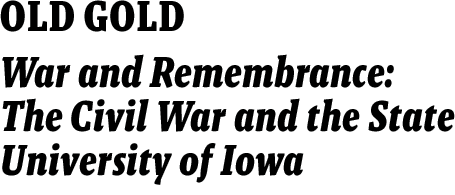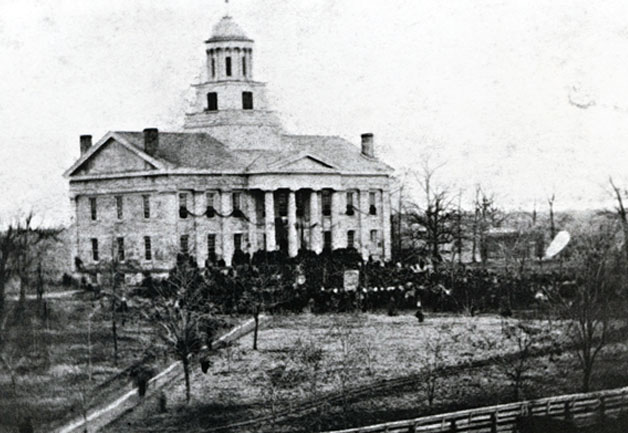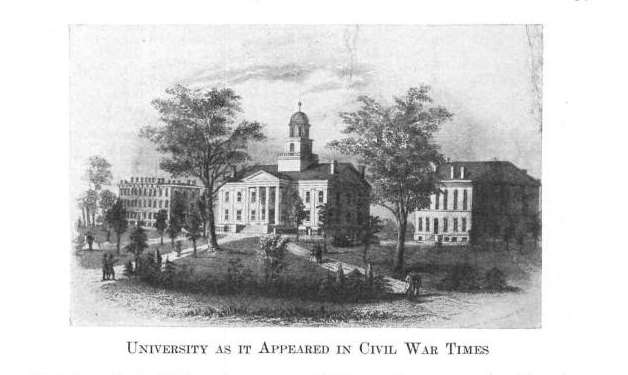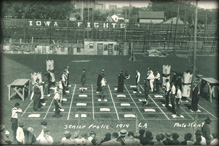-
Page Navigation Links:
- Skip to Site Navigation Links
- Skip to Features

- The University of Iowa
- Spectator
- Monthly News for UI Alumni and Friends

In the early hours of April 12, 1861, Confederate soldiers under Gen. Pierre Beauregard opened fire on Fort Sumter, South Carolina, marking the beginning of the Civil War. As news of the war’s outbreak spread, reactions—and enlistments—followed. The State University of Iowa was no exception, 150 years ago this spring.
In his essay, “The State University of Iowa and the Civil War” (Annals of Iowa 30, January 1950: 198–209), Harrison John Thornton, a professor of history at the University, described a scene of “excited throngs gather(ing) on the streets to discuss the merits and demerits of the policy of the administration” after news of the Fort Sumter attack reached Iowa City. Thornton drew largely from Iowa City newspaper accounts of the time. While some expressed sympathy with the Confederacy, he wrote, “The prevailing sentiment was that party politics should be forgotten and the great cause of the Union should prevail.”
On April 20, about one week after the Fort Sumter attack, a large crowd gathered at the corner of Clinton and Washington streets—the southeast corner of the Old Capitol lawn—to hear speakers including Gov. Samuel J. Kirkwood, Mayor George W. Clark, and others. Thornton, referring to a diary by Charles M. Howe, a University student at the time, noted “much military maneuvering on the campus. Night after night students met for war exercises in the old Athenaeum which stood at the corner of Clinton and Market streets, drawn there by a stern sense of the grave danger which threatened the nation.”
Iowa City residents and University students were represented in numerous contingents throughout the conflict, perhaps most notably in Company D of the 44th Iowa regiment of the U.S. Army. In 1864, the company was organized in response to a call for short-term volunteers who could serve for 100 days.
Spearheading this effort were two members of the SUI faculty: Charles E. Borland, who was principal of the University’s preparatory department, and Thomas Calver, head of gymnastics and military drill. About 80 students from three area schools—SUI, Cornell College, and Western College, a now-defunct school located in Shueyville at the time—enlisted in Company D. Half of the 80 were SUI students.
The number of male students at the University declined sharply during the war years. In the fall of 1860, campus enrollment was 172, with the number of male and female students evenly divided. By the fall of 1862, however, women outnumbered men by nearly two to one: 187, compared with 101. The enrollment returned to a more normal parity in the fall of 1865 following the end of the conflict.
To observe the sesquicentennial of the Civil War, the experiences of Iowans and others are recounted in an exhibit in the north lobby of the University of Iowa’s Main Library this spring. Now Do Not Let Your Courage Fail: Voices from the Civil War will be open to the public from April through July.
The Department of Special Collection’s web site includes a subject guide to Civil War–related materials. Several resources of interest are also noted in a military and wartime service guide on the University Archives’ web site.
Note: Old Gold often uses the University’s original and official name—The State University of Iowa (SUI)—in historical contexts. See this December 2010 article for more about the University’s names.
—David McCartney, University Archivist
Images of the Old Capitol draped in crepe for memorial service for President Abraham Lincoln, April 1865.
 [University Archives: F.W. Kent Collection of Photographs (RG 30.01.01), Buildings series, Old Capitol 1840 to 1939 folder]
[University Archives: F.W. Kent Collection of Photographs (RG 30.01.01), Buildings series, Old Capitol 1840 to 1939 folder]

[Iowa Alumnus 9 (November 1911): p. 39]
NEXT MONTH:
The Senior Frolic,
a springtime ritual

Source—the Iowa Digital Library: F.W. Kent Collection of Photographs (RG 30.01.01), Events and Activities Series, Senior Frolic folder
If you’ve got memories to share, please send them to Spectator and we’ll run some next month.
Previous Old Gold editions:
© The University of Iowa 2009